Toyota Camry (XV70)
| Toyota Camry | |
|---|---|
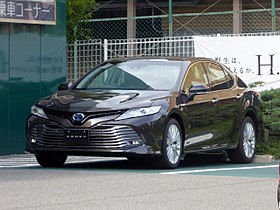
Toyota Camry (XV70)
|
|
| Overview | |
| Manufacturer | Toyota |
| Production | 1982–present |
| Body and chassis | |
| Class |
|
| Layout | Transverse front-engine, front-wheel drive |
| Chronology | |
| Predecessor | |
| Celica Camry (A40/A50) | |
|---|---|
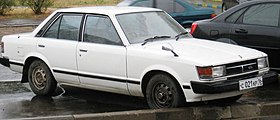
Celica Camry XT Super Edition (Japan)
|
| V10 | |
|---|---|

Camry DX sedan (US; facelift)
|
|
| Overview | |
| Also called | Toyota Vista |
| Production | March 1982 – July 1986 |
| Model years | 1983–1986 |
| Assembly | Japan: Toyota, Aichi (Tsutsumi plant) |
| Body and chassis | |
| Body style | |
| Layout | Transverse front-engine, front-wheel-drive |
| Powertrain | |
| Engine | |
| Transmission |
|
| Dimensions | |
| Wheelbase | 2,600 mm (102.4 in) |
| Length |
|
| Width | 1,690 mm (66.5 in) |
| Height |
|
| Curb weight | 990–1,130 kg (2,180–2,490 lb) |
| V20 | |
|---|---|
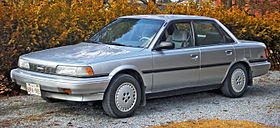
Camry LE sedan (Canada; pre-facelift)
|
|
| Overview | |
| Also called |
|
| Production |
|
| Assembly |
|
| Designer | Seiichi Yamauchi (1984) |
| Body and chassis | |
| Body style |
|
| Layout | |
| Powertrain | |
| Engine | |
| Transmission |
|
| Dimensions | |
| Wheelbase | 2,600 mm (102.4 in) |
| Length |
|
| Width | 1,695 mm (66.7 in) |
| Height |
|
| Curb weight | 1,080–1,295 kg (2,381–2,855 lb) |
| V30 | |
|---|---|
 |
|
| Overview | |
| Also called | Toyota Vista |
| Production | July 1990 – June 1994 |
| Assembly | Japan: Toyota, Aichi (Tsutsumi plant) |
| Designer | Osamu Shikado (1988) |
| Body and chassis | |
| Body style | |
| Layout | |
| Related | |
| Powertrain | |
| Engine | |
| Transmission |
|
| Dimensions | |
| Wheelbase | 2,600 mm (102.4 in) |
| Length |
|
| Width | 1,695 mm (66.7 in) |
| Height |
|
| Curb weight | 1,180–1,360 kg (2,600–3,000 lb) |
| V40 | |
|---|---|
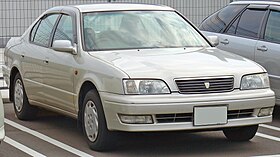 |
|
| Overview | |
| Also called | Toyota Vista (V40) |
| Production | 1994–1998 (JDM) |
| Assembly | Japan: Toyota, Aichi (Tsutsumi plant) |
| Body and chassis | |
| Body style | |
| Layout | |
| Powertrain | |
| Engine | |
| Dimensions | |
| Wheelbase | 2,650 mm (104.3 in) |
| Length | 4,625 mm (182.1 in) |
| Width | 1,695 mm (66.7 in) |
| Height | 1,410–1,435 mm (55.5–56.5 in) |
| V50 (Vista) | |
|---|---|
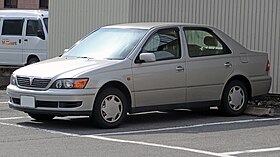 |
|
| Overview | |
| Production | 1998–2003 |
| Assembly | Japan: Toyota, Aichi (Tsutsumi plant) |
| Body and chassis | |
| Body style |
|
| Layout | |
| Platform | Toyota MC platform |
| Powertrain | |
| Engine |
|
| Dimensions | |
| Wheelbase | 2,700 mm (110 in) |
| Length | 4,670 mm (184 in) |
| Width | 1,695 mm (66.7 in) |
| Height | 1,505–1,515 mm (59.3–59.6 in) |
| Curb weight | 1,310 kg (2,890 lb) |
| XV10 | |
|---|---|

Pre-facelift Camry sedan (Australia)
|
|
| Overview | |
| Also called |
|
| Production |
|
| Model years | 1992–1996 |
| Designer | Osamu Shikado (1988) |
| Body and chassis | |
| Body style |
|
| XV20 | |
|---|---|

Pre-facelift Vienta sedan
|
|
| Overview | |
| Also called |
|
| Production |
|
| Model years | 1997–2001 |
| Body and chassis | |
| Body style |
|
| Powertrain | |
| Engine | |
| XV30 | |
|---|---|

Pre-facelift Camry (regular)
|
|
| Overview | |
| Also called | Daihatsu Altis |
| Production |
|
| Model years | 2002–2006 |
| Body and chassis | |
| Body style | 4-door sedan |
| Platform |
|
The Toyota Camry (/ˈkæmri/; Japanese: トヨタ・カムリ Toyota Kamuri) is an automobile sold internationally by the Japanese manufacturer Toyota since 1982, spanning multiple generations. Originally compact in size (narrow-body), later Camry models have grown to fit the mid-size classification (wide-body)—although the two sizes co-existed in the 1990s. Since the release of the wide-bodied versions, Camry has been extolled by Toyota as the firm's second "world car" after the Corolla. In Japan, Camry is exclusive to Toyota Corolla Store retail dealerships. Narrow-body cars also spawned a rebadged sibling in Japan, the Toyota Vista (トヨタ・ビスタ)—also introduced in 1982 and sold at Toyota Vista Store locations. Diesel fuel versions have previously retailed at Toyota Diesel Store.
Between 1979 and 1982, the Camry nameplate was delegated to a four-door sedan model in Japan, known as the Celica Camry. When Camry became an independent model line in 1982 with the V10 series, Toyota made it available as a five-door liftback in addition to the sedan. The subsequent Camry V20 series, debuted in 1986 with a station wagon substituting the liftback body variant and Japan-only hardtop sedans making their debut. The company replaced the V20 in 1990 with the V30 sedan and hardtop, but this model series was exclusive to Japan. Automotive tax regulations in that country dictated the retention of a narrower body as utilized in previous Camry generations. However, overseas demand for a larger Camry resulted in the development of a wide-body XV10 sedan and station wagon that arrived in 1991. Japan also received the wider XV10 as the Toyota Scepter (トヨタ・セプター). The company then issued an XV10-bodied coupé in 1993 that was spun off in 1998 as an independent model line, titled Camry Solara.
...
Wikipedia
